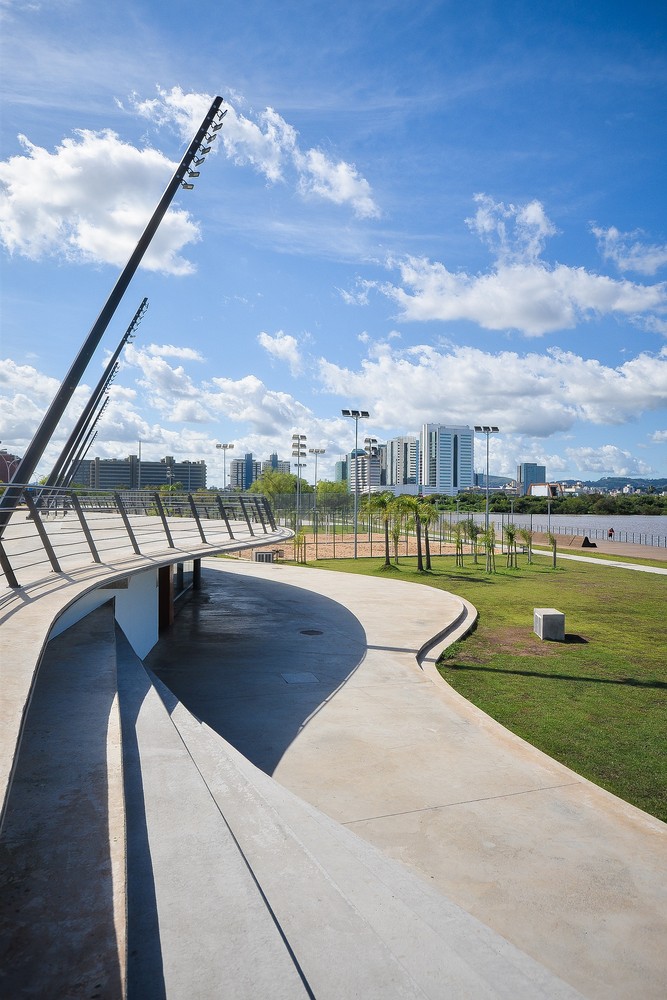Taubman Complex at Lawrence Tech Morphosis Architects
2016-10-26 09:00
© Nic Lehoux
C.Nic Lehoux


架构师提供的文本描述。阿尔弗雷德陶布曼工程、建筑和生命科学综合体是位于密歇根州南菲尔德的劳伦斯技术大学的一座新的36,700 SF学术实验室大楼,为机器人工程、生物医学工程、生命科学和相关项目提供先进设施。这座建筑的设计是围绕着在多个尺度上加强连通性的机会而演变的-学校的各种工程和设计学科以前设在不同的建筑中,现在和未来的校园区域也是如此。
Text description provided by the architects. The A. Alfred Taubman Engineering, Architecture, and Life Sciences Complex is a new 36,700 SF academic laboratory building for Lawrence Technological University in Southfield, Michigan, that provides advanced facilities for robotics engineering, biomedical engineering, life sciences and related programs. The design of the building evolved around opportunities to enhance connectivity at multiple scales – between the school’s various engineering and design disciplines, previously housed in separate buildings, as well as within existing and future regions of the campus.
© Morphosis - Diagram
形态图


陶布曼建筑群是在猛虎大学的主要扩建和翻新工作中建造的首批建筑之一,这将增加新的校园区域、建筑物和设施,以服务于该大学日益增长的学生人数。为了支持这一努力,建筑群被设计成一个“可挤压的部分”:一个可以分阶段扩展以适应增长,同时保持建筑物功能和设计完整性的可占用钢筋。酒吧的脊柱是由两层的实验室构成的,它们可以向外看一个开放的弯曲空间,这个空间一直延伸到建筑物的长度。这个灵活的空间是Taubman综合体的协作中心,为非正式讨论、引经据典的评论会议和讲座提供了一个扩展的、可重构的大厅。通过东面的ETFE(乙烯四氟乙烯)薄片,牧师的玻璃窗充满了弯曲的空间;到了晚上,这个光柱就会被建筑物内的光线所照亮。
The Taubman Complex is among the first buildings constructed in LTU’s major expansion and renovation effort, which will add new campus regions, buildings, and amenities to serve the university’s growing student population. To support this effort, the Complex is designed as an “extrudable section:” an occupiable bar that can be extended in phases to accommodate growth while maintaining the function and design integrity of the building. The spine of the bar is formed by two floors of laboratories, which look out into an open flex-space that runs the length of the building. This flex space is the collaborative heart of the Taubman Complex, providing an expansive and re-configurable hall for informal discussions, pin-up critique sessions, and lectures. Clerestory glazing fills the flex-space with light diffused through an ETFE (ethylene tetrafluoroethylene) scrim along the east facade; in the evening, this scrim becomes illuminated by light from within the building.
© Nic Lehoux
C.Nic Lehoux


© Nic Lehoux
C.Nic Lehoux


除了增加灵活的合作空间和实验室设施外,我们还确定了利用建筑物的形式为学校建立一个新的轴线的机会,这将加强现有建筑物之间的联系,并充当通往校园未来区域的桥梁。这座建筑的桥型决定了校园的外围,并从相邻的主要道路上增强了大学的存在和视野。这座建筑群通过架起桥梁与邻近的建筑相连,构成了通往大学的一个新的宏伟入口和门户。突破建筑物的线性形式,碳纤维循环的“球体”包含主楼梯和标志进入建筑物,同时创建一个重点大学四。
Beyond adding flexible collaborative spaces and laboratory facilities, we identified opportunities to use the form of the building to establish a new axis for the school that would enhance links between existing buildings and act as a bridge to future regions of the campus. The bridge-like form of the building defines the periphery of the campus and enhances the presence and view of the University from the adjacent major roadway. The Complex is linked to neighboring buildings by lifted bridges, framing a new grand entrance and gateway to the University. Breaching the linear form of the building, a carbon-fiber circulation “orb” contains the main staircase and marks entry to the building, while creating a focal point for the University quad.
© Nic Lehoux
C.Nic Lehoux


© Morphosis - Section
3.形态学-剖面


© Nic Lehoux
C.Nic Lehoux


一个轻盈的,可扩展的建筑设计的先例植根于我们合作的建筑师和工程公司艾伯特卡恩协会的历史,以及底特律作为美国工程创新中心的历史。阿尔伯特·卡恩(Albert Kahn)是新兴汽车行业的主要建筑师;他的委员会包括亨利·福特(Henry Ford)众多最先进的工厂,这些工厂采用了卡恩和他的兄弟朱利叶斯(Julius)设计的革命性结构体系,以创造出一种开阔的跨度,灯火通明的组装层。这些建筑的成功取决于结构肋和门窗的反复系统-一种高效、模块化的公式,可以扩展到任何必要的大小,以适应项目内部的需要。一个世纪后,卡恩的创新在劳伦斯科技大学的一次新的扩张中复活,旨在为不断发展的研究和学科提供灵活的实验室设施。
The precedent for a light-filled, extendable building design is rooted in the history of our teaming architect and engineering firm, Albert Kahn Associates, and of Detroit as the center for American innovation in engineering. Albert Kahn was the primary architect for an emerging automobile industry; his commissions included numerous state-of-the-art factories for Henry Ford, which employed a revolutionary structural system engineered by Kahn and his brother Julius to allow for the creation of open span, brightly lit assembly floors. The success of these buildings depended on a repeated system of structural ribs and clerestory windows – an efficient, modular formula that could be expanded and extended to whatever size necessary to accommodate the program within. A century later, Kahn’s innovations are revived in a new expansion for Lawrence Technological University designed to offer flexible laboratory facilities for evolving research and disciplines.
© Nic Lehoux
C.Nic Lehoux




















































Architects Morphosis
Location 21000 W 10 Mile Rd, Southfield, MI 48075, United States
Category Educational Architecture
Design Director Thom Mayne
Project Principal Brandon Welling
Project Architects Aleksander Tamm-Seitz
Project Team Chris Eskew, Michael Nesbit, Atsushi Sugiuchi
Area 11613.0 sqm
Project Year 2016
Photographs Nic Lehoux































